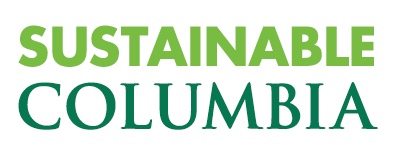Progress Since Columbia's First Sustainability Plan (2017 - 2020)
The University has made significant progress since the launch of the first sustainability plan in 2017. Click to expand each section below to learn more about the progress made at each of Columbia's campuses.
"Morningside+" (MS+) is a designation that applies to the boundaries of the initial Columbia greenhouse gas (GHG) inventory that was reported to The Climate Registry (TCR). The boundaries include all of Columbia’s campuses except Columbia University Irving Medical Center (CUIMC), Lamont-Doherty Earth Observatory (LDEO), Global Centers, and miscellaneous stand-alone buildings in midtown and downtown Manhattan.
Morningside+
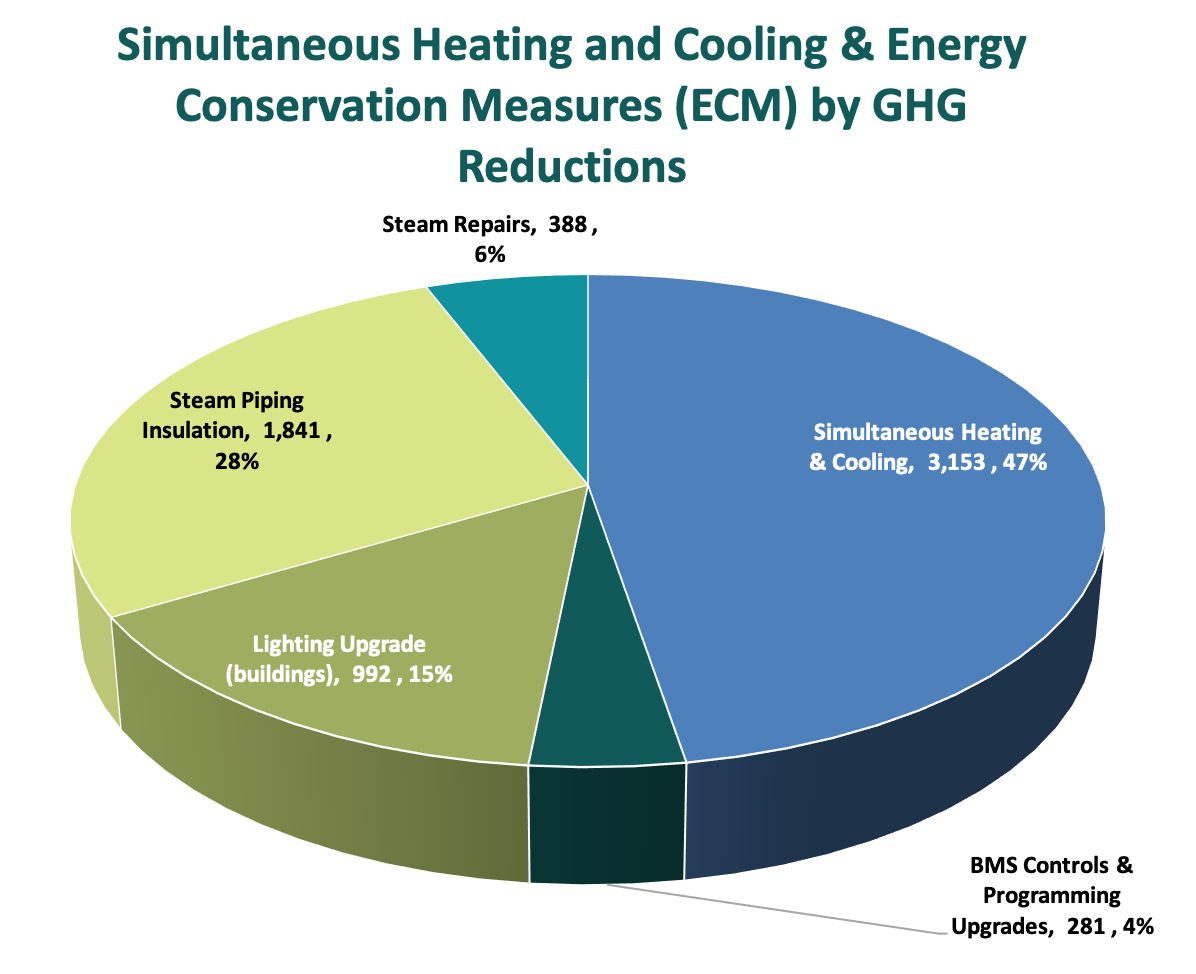
- Retro-commissioning measures (RCMs)
- As of January 2021, all 321 measures have been completed.
- 83 additional measures were identified due to ongoing audits and were able to be implemented.
- The estimated GHG reduction for the identified and completed measures is 2,817 Mtons CO2e.
- As of January 2021, all 321 measures have been completed.
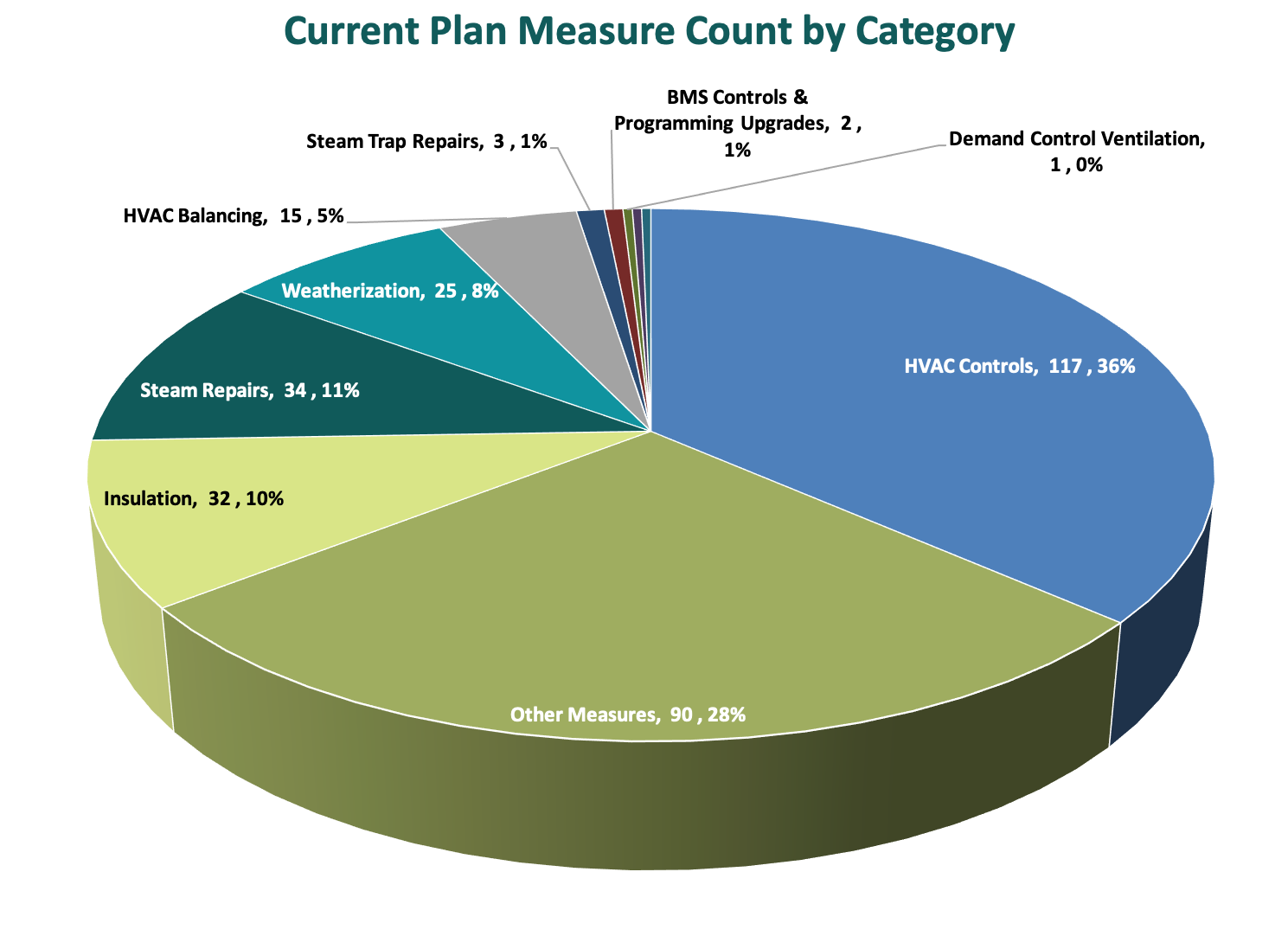
Columbia University Irving Medical Center (CUIMC)
Lighting: To comply with LL88 and to permanently reduce carbon emissions, CUIMC completed several lighting upgrades in its facilities. Replacing incandescent and fluorescent lighting fixtures with high efficiency LED fixtures with controls saved 1,921 Mega-Watt Hours (MWH). Local utilities provided 56% of the total project cost as incentives, which led to a payback of fewer than two years for CUIMC. Notable projects include installing LED lighting fixtures in 400 apartments, and converting the lighting to LED in every laboratory and office space located in the Vagelos College of Physicians and Surgeons Building. The energy saved equals the power consumed by 157 single-family homes in the United States for an entire year. Read more.
Campus-Wide Gas Savings: In 2019, CUIMC Facilities Management audited its entire steam traps and steam pipe insulation needs across its portfolio, and identified several projects that could reduce the Medical Center’s energy consumption. CUIMC completed most of the steam pipe insulation projects with a return on investment of fewer than eight months, reducing 70,400 Therms or $62,000 annually from the core utility budget. CUIMC received an impressive 80% of the project cost as rebates and incentives from the local utilities for completing these projects. Similarly, an additional 200,000 Therms in savings has been identified for completion by April 2021, covering both insulation and steam traps.
Ultra-Low Efficient Freezer Exchange Program: Engaging stakeholders is vital to achieving substantial energy savings. CUIMC's research laboratories are incredibly energy-intensive. As a pilot program, CUIMC Facilities Management partnered with the Office for Research at Vagelos College of Physicians Surgeons, the CUIMC Procurement Office, and Con-Edison to promote energy-efficient freezers for laboratories throughout the campus. The pilot program completed its goal to replace 25 out of 500 freezers. Lessons learned from this pilot program will replace all freezers at CUIMC in the coming years. Read more.
Fuel Switching: Over the years, CUIMC has been diligently moving away from using No 2 oil as a fuel source for heating. Russ Berrie Medical Science Pavilion, Lasker Biomedical Research Center, and Irving Cancer Research Center's tariff moved to 100% natural gas from an interruptible tariff. Simultaneously, 100 Haven Avenue’s plant switched from using No 2 oil as a primary source to natural gas a few years ago, thereby reducing the overall carbon emissions at each location.
Lamont-Doherty Earth Observatory (LDEO)
- Standardized multi-year capital project to renovate 1960’s vintage Instrument Lab building to include LED lighting, window and shutter door replacement, wall and roof insulation.
- Replaced boilers in Administration, Oceanography, and Monell buildings with high-efficiency models.
- Construction of improvements to the campus water distribution system include a new insulated 75,000 gallon storage tank.
- The project eliminated a natural gas boiler heating system for tank freeze protection, and introduced new low head, variable speed drive, domestic service pumps operating 95% of the time and reducing electric energy consumption to operate the distribution system by 38%.
- Recommissioned multiple laboratories in Comer Geochemistry laboratory building during new lab construction to maintain existing building ventilation air balancing and avoid the installation of new energy intensive HVAC equipment.
- Added dry cooler in parallel with chilled water production plant to provide free winter cooling in Comer Geochemistry laboratory building.
- The Comer building is LDEO's most energy-intensive building, responsible for 38.6% of all energy usage on campus.
Morningside+
- Exceeded 2020 goal of 35% absolute emissions reduction from Scope 1 emissions from stationary combustion of fuel, and Scope 2 purchased electricity emissions.
- Aligned with international protocols and public reporting through The Climate Registry (TCR)
- Created Columbia-specific accounting tool to centrally manage all University emissions (Scope 1, 2, and 3).
- Expanded reporting from Scope 1 and 2 only to include Scope 3.
- Publicly reported emissions to TCR for 2006 through 2019. Click the respective links to view third-party verified inventories for CY2006, CY2017, CY2018, and CY2019.
- Enhanced data collection for transportation emissions sources:
- In 2018, Columbia began using a survey as a tool to collect air travel and commuting behavior from University stakeholders. The results from this survey were used to estimate total miles traveled, and associated emissions for the University.
- To baseline data for entry into the TCR GHG inventory, Columbia is now collecting fuel consumption and mileage data from campus vehicles and contracted fleets. This information is used to calculate emissions data. To collect baseline data, an Earth Institute capstone group researched best-practice methodologies to determine a path forward.
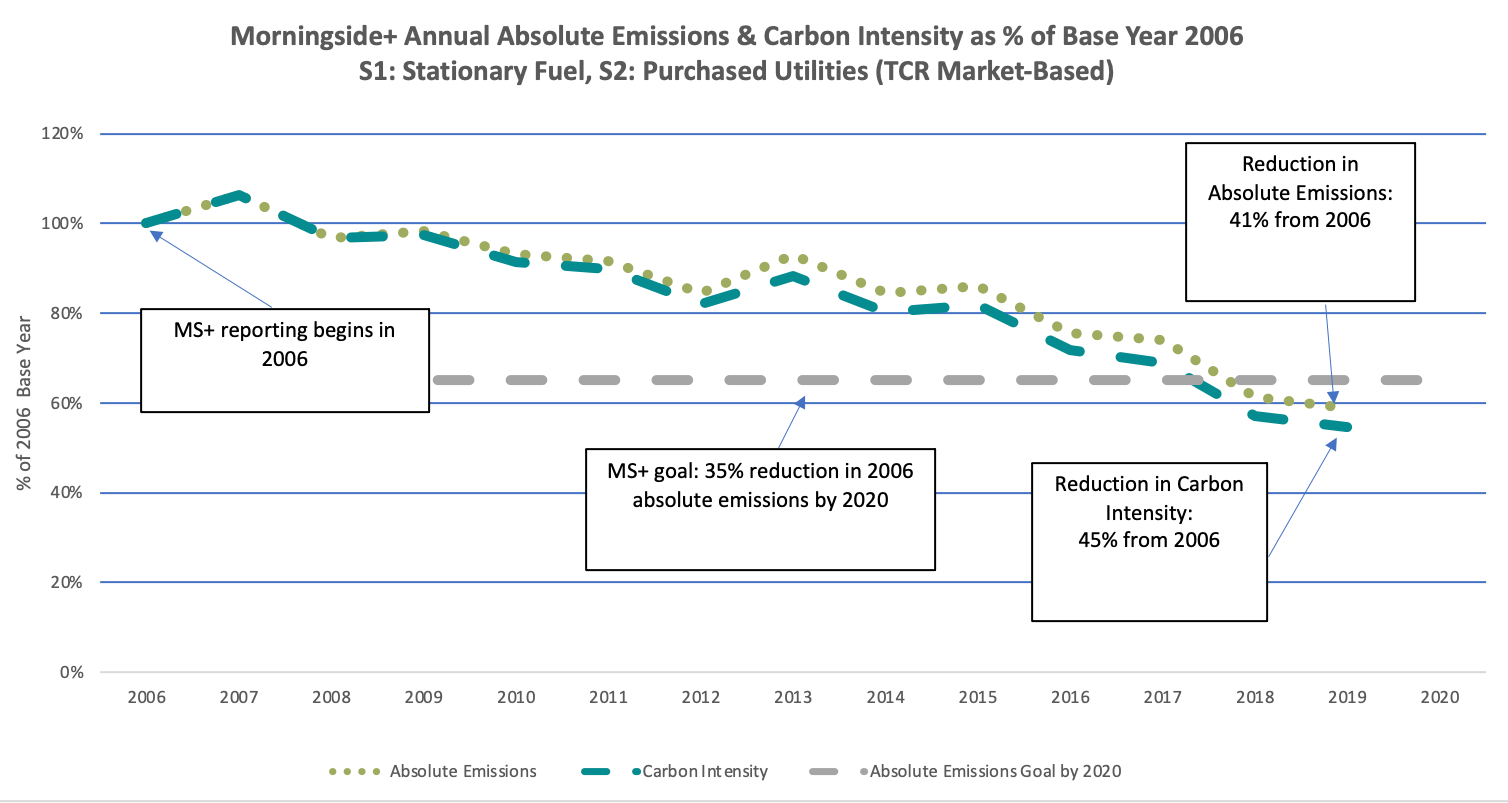
CUIMC:
- CUIMC updated its portfolio manager profile to accurately report energy consumption on all of its buildings. The changes included an update in building identification number, block, lot, and square footage information. This update was important for the following reasons:
- It prepares CUIMC for the Climate Mobilization Act.
- It complies with Local Law 84 that requires an energy grade to be posted outside each building greater than 25,000 sq. ft.
- It prevents CUIMC from paying the penalty for non-compliance due to an inaccurate submission.
- Data Transparency: CUIMC reports its carbon emissions to stakeholders using local coefficients that allow management to plan projects and programs for compliance with local laws. Since none of this data is verified, CUIMC engages consultants and a verification agency to verify its carbon emission data align with international protocols. CUIMC, like Morningside, will independently report to TCR.
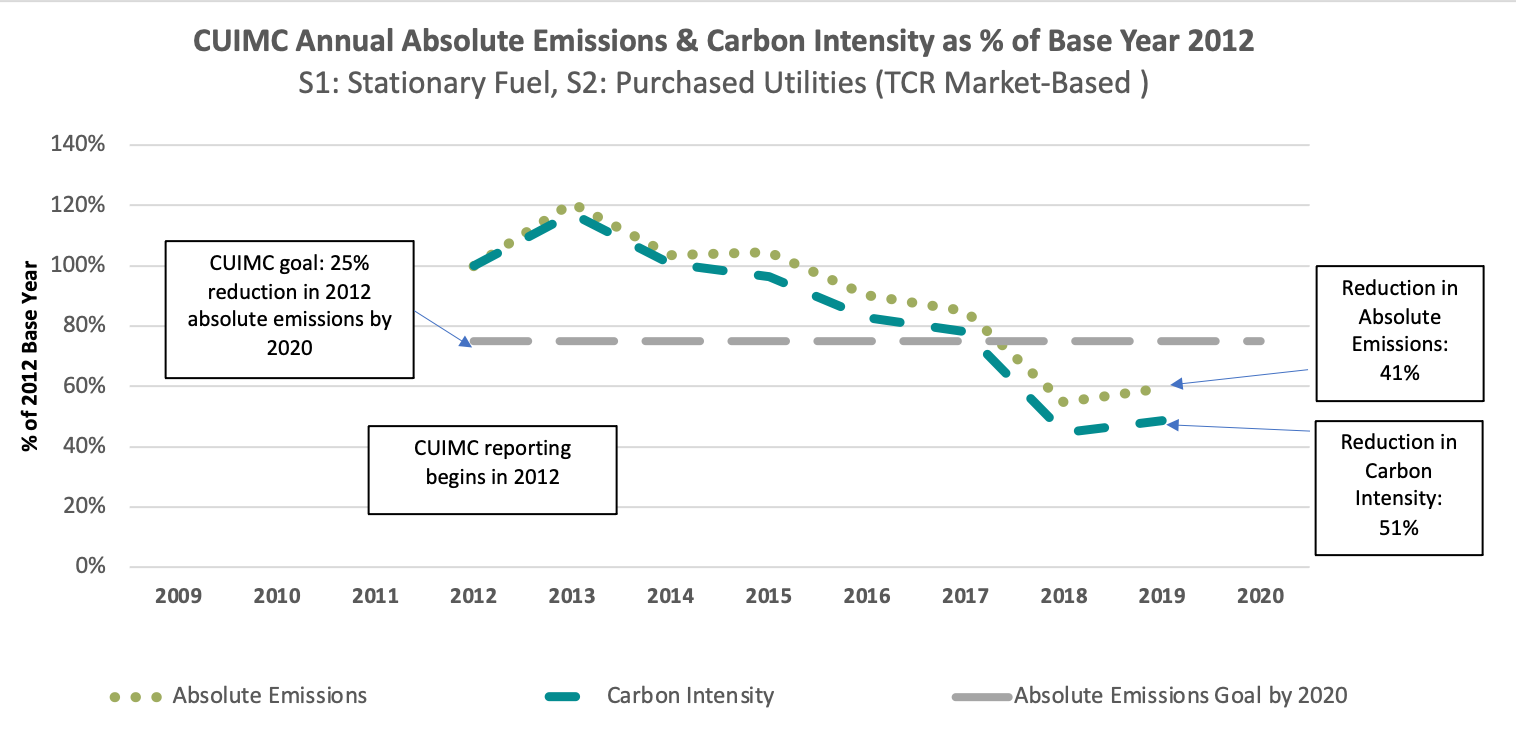
LDEO:
- Exceeded goal of 50% absolute emissions reduction from the 2016 baseline by 2020.
- Commenced production from 4 MW solar farms in July of 2008, currently providing 86% of campus electric requirements with zero emissions.
- Completed schematic design for the renovation of Lamont Hall to provide a new campus conference and visitor center.
- This landmark-able signature building is expected to be the first zero-emissions building on campus, featuring geothermal heating and cooling.
- Completed NYSERDA Phase 1 and Phase 2 pilot studies of a ground source geothermal well field central on campus to serve four existing buildings: Monell, Oceanography, Cafeteria, and Administration.
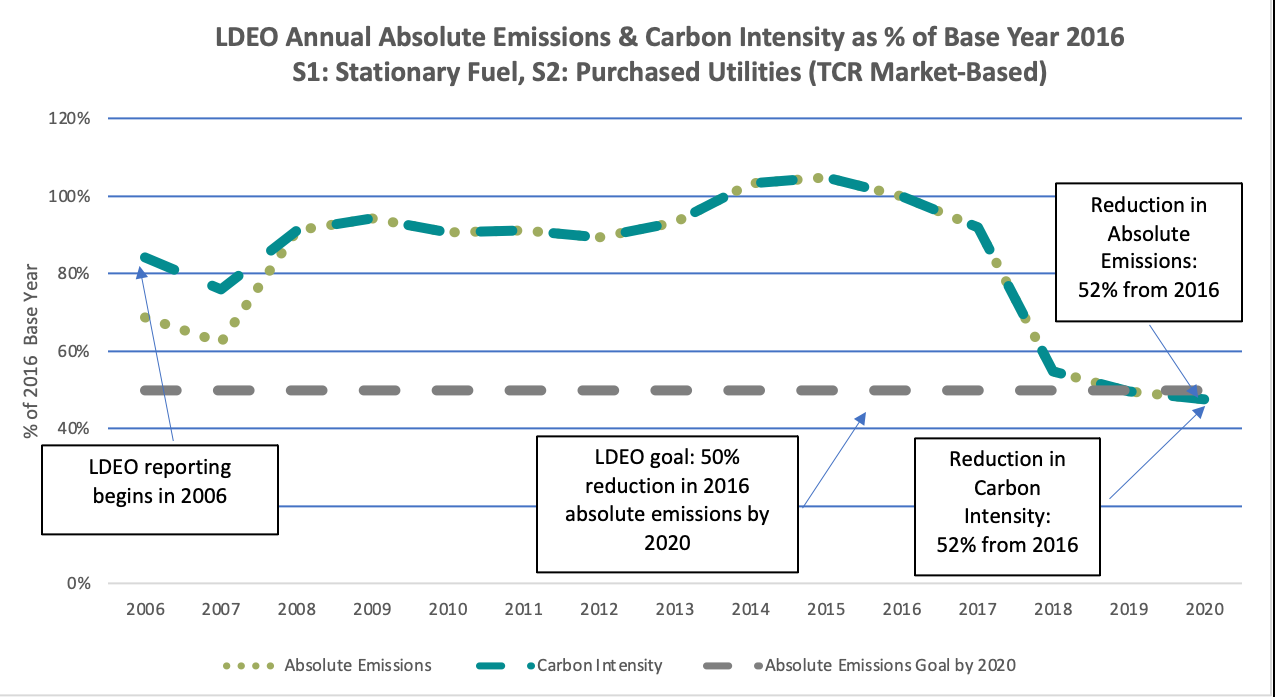
100% transition from diesel to electric University shuttle buses:
- Six new battery electric buses began operating on Columbia’s campus shuttle network, replacing the existing diesel-powered buses.
- The buses were among the first electric buses to be introduced in New York City, and they offer both environmental and health benefits, including reduced emissions and noise pollution, and improved air quality.
- The shuttles make over 1,400 rider trips daily and travel nearly 180,000 miles per year.
- Transitioning to electric buses has helped the University to reduce shuttle GHG emissions by over 270 metric tons – a 70 percent reduction from the diesel-powered shuttle buses.
Awards and Recognition:
Columbia was recognized as the top school for Transportation in the Association for the Advancement of Sustainability in Higher Education (AASHE)'s 2018 and 2019 Sustainable Campus Index.
Morningside+
Sustainable Commuting
- Bike parking at Columbia includes over 600 bike parking spaces which includes sheltered and secured bike parking as well as outdoor bike parking scattered around campus.
- In 2018, Columbia's Dodge Fitness Center began offering a shower pass membership for active commuters, such as cyclists and runners. The membership includes a locker and free towel service.
- Reduced single occupancy vehicle (SOV) rates year over year; under 2% and 17% SOV rates for students and employees respectively as of February 2020.
- Columbia has made substantial investments in providing near-to-campus housing for students and employees, which has helped Columbia achieve winning transportation demand management (TDM) results.
- Columbia launched the Smart Commuter badge initiative to affect behavior change across the University.
- Beginning in 2018, Columbia provides parking discounts to Manhattanville employees and construction workers for carpools of three or more people per vehicle.
- Established a Columbia-operated park and ride service that has achieved a 100 percent conversion of SOV commuters.
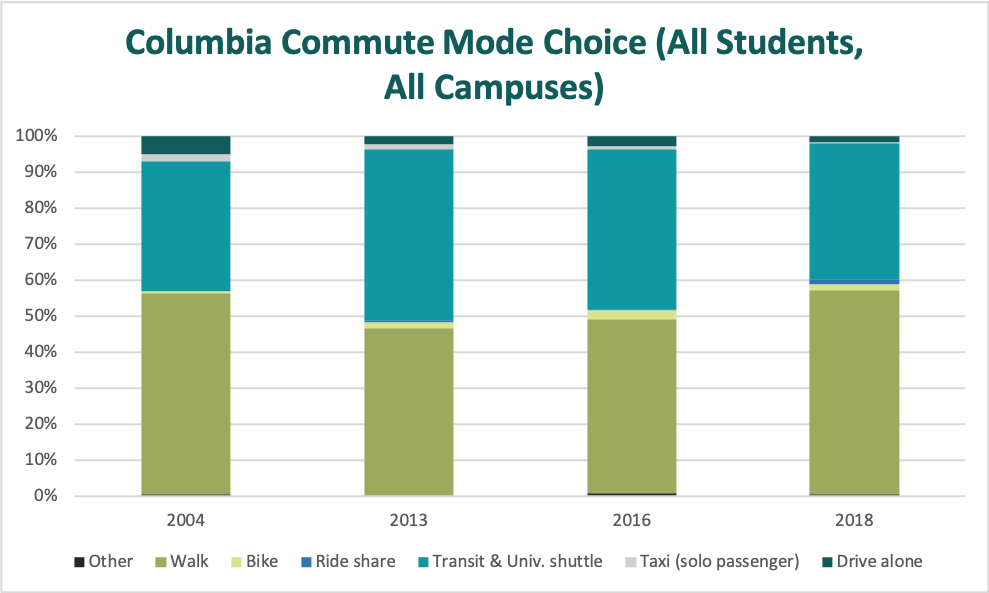
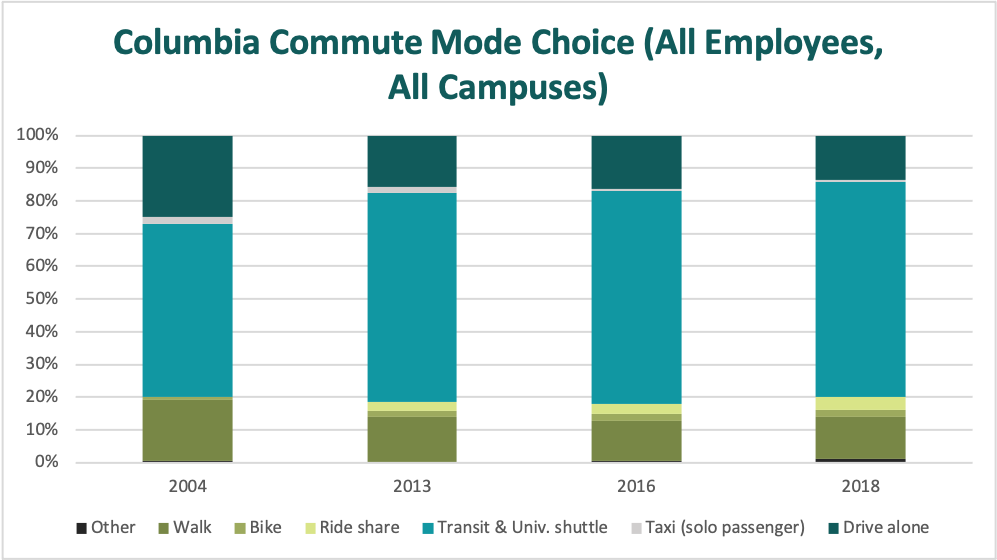
CUIMC:
- CUIMC increased the availability of electric vehicle charging ports from three to 11 over the last four years. To install additional chargers in the future, CUIMC Facilities Management also completed electrical infrastructure upgrades at Irving Cancer Research Center.
- CUIMC instituted a bike rack management and augmentation plan to support the biking needs of the Medical Center’s students, faculty, and staff. Initiatives under this plan include:
- Printed signage that includes a QR code linking to a webpage with a campus-wide map and list of all existing CUIMC bike rack locations was installed at each bike location to prevent overcrowding or underuse.
- Two bike-repair stations that are available 24 hours a day, seven days a week, 365 days a year were installed.
- Current bike parking capacity has increased to 183, with additional space for installing 72 bikes has been identified under this plan.
- In 2020, CUIMC Facilities Management partnered with CitiBike and gave away more than 200 free annual memberships to CUIMC essential workers.
LDEO:
- Installed an electric bus charging station on campus to facilitate the conversion of the Lamont Shuttle service from diesel to electric buses.
- Provided limited access to campus parking lots for commuters from suburbs west of the Hudson River to park and ride the Lamont Shuttle to Morningside campus.
- Obtained NYSERDA funding to install 4 electric vehicle charging ports on campus.
- Installed several new parking racks and repair stations to support bicycle commuting and recreational use on campus.
- Adopted a new bicycle wheel friendly storm drain standard for campus roadways.
- Participated and promoted 511NY Rideshare program with regular on-campus outreach events to employees, as well as public outreach at annual Lamont Campus Open House event.
Morningside+
- Organics program grew from 269,264 tons in 2017 to 470,579 by the start of 2020 (an increase of 75%) until the program was suspended due to COVID-19.
- Developed a new waste data tracking system to import into TCR GHG emission inventory (conducted by a student capstone project).
- Received a State Recycling Leadership Award.
- Overhauled waste receptacles with new signage, created in collaboration with members of the Sustainable Leaders Network, complete with improved, widened lids on bins for easier accessibility.
- Removed personal desk-side bins and continually encourage a central location for all bins.
- The result is that more thought goes into where an item is placed for disposal. It also creates efficiency for custodial staff and results in reduced use of plastic, petroleum-based liners.
- Despite a relatively stagnant diversion rate, the University now sends 95% of waste generated from academic buildings to a waste-to-energy plant, reducing the amount of waste sent to landfill to only 5%.
- Single-use plastics continue to be phased out in various schools and departments.
- For example, plastic water bottles are systematically replaced with water-filling stations throughout campus.
- The Sustainable Events working group conducted a survey with event planners on campus to establish a baseline of existing event sustainability practices to identify areas for improvement. This working group continues to regularly meet and work toward strategies, recently creating sub-teams to achieve progress in a variety of areas.
- Created and published Sustainable Event guidelines for the University.
CUIMC:
- To improve recycling collection, CUIMC adopted trash and recycling standards in line with the Morningside campus.
- A pilot was initiated at the Vagelos College of Physicians and Surgeons Building in which new bins and signage were installed. Lessons learned from the implementation will be used to expand the program throughout the campus.
LDEO:
- Continuously maintained waste separation and measurement program since 2005 with over 50% of waste generated on campus diverted from landfills and recycled.
- Expanded paper recycling program to include annual document destruction service to ensure compliance with University record retention policy.
- Eliminated single-use plastic bottles in cafeteria and provided refill station for reusable bottles. Also provided reusable plastic containers for sale in cafeteria to reduce waste.
- Upgraded signage and waste receptacles across campus, indoors and out, to promote recycling.
- Maintained inventory of reusable furniture on campus for renovations and to support new requirements.
- Creation of Sustainable Leaders Network Workspace Certification Program, which has grown to over 200 participants in three years at Morningside, Manhattanville, and the Medical Center campuses.
- The University has actively engaged with students through graduate and undergraduate capstone projects, exploring a range of topics from water conservation to transportation emissions reduction strategies.
